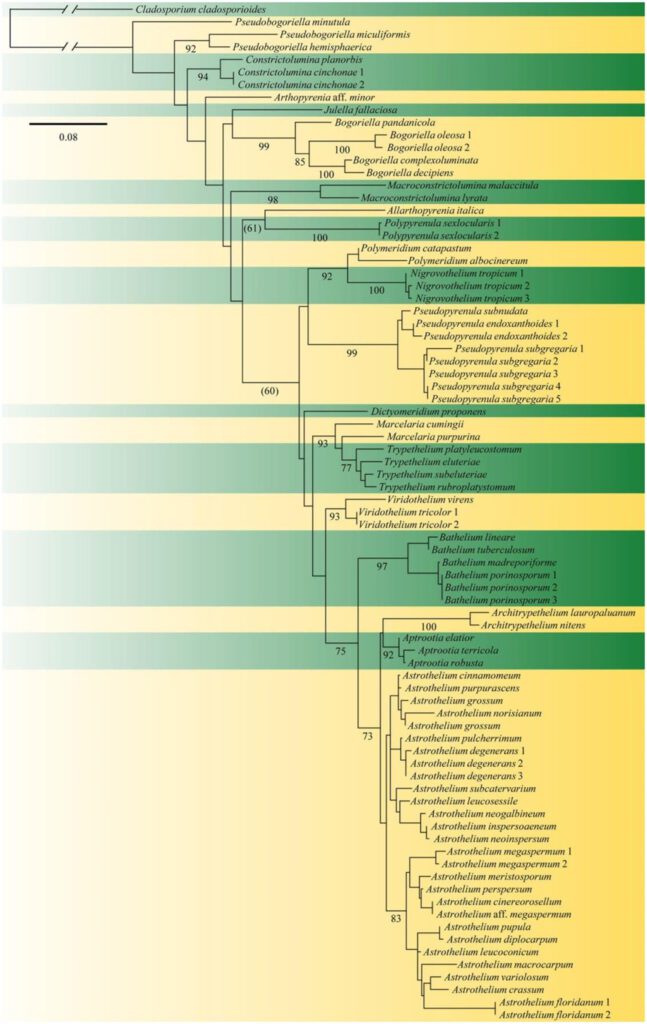Polypyrenula D. Hawksw., Bull. Br. Mus. Nat. Hist., Bot. 14: 165 (1985).
MycoBank number: MB 25730; Index Fungorum number: IF 25730; Facesoffungi number: FoF 08806; one morphologically and phylogenetically defined species (MirandaGonzález et al. 2020).
Lichenized (sometimes indistinctly or photobiont apparently absent) on bark in terrestrial, lowland tropical, season ally dry forest habitats. Thallus ecorticate, whitish to pale greyish or brownish. Photobiont (when present) Trente pohlia. Ascomata dispersed, solitary, erumpent to prominent, black but basally covered by thin thallus layer, hemisphaerical to wart-shaped, carbonaceous, ostiolate, ostiole apical. Involucrellum well-developed, carbonaceous. Excipulum prosoplectenchymatous, basally reddish brown, laterally and apically thin and fused with involucrellum. Hamathecium comprising 0.5–1 µm wide paraphysoids, hyaline, straight, branched and anastomosing, embedded in a gelatinous matrix. Asci (6–)8-spored, bitunicate, clavate, shortly pedicellate, with a non-amyloid ocular chamber. Ascospores biseriate, fusiform-ellipsoid and tapering towards the distal end, reddish brown but with basal cell paler, 5(-6)-septate, with distinct distosepta and rounded lumina except for the lowermost cell which is separated by a thin euseptum and has a triangular lumen, smooth-walled, not constricted at the septa, lacking a gelatinous sheath. Pycnidia unknown.
Chemistry: no substances detected by TLC.
Type species: Polypyrenula sexlocularis (Müll. Arg.) D. Hawksw., Bull. Br. Mus. Nat. Hist., Bot. 14: 165 (1985) [= Polypyrenula albissima Aptroot, Biblioth. Lichenol. 44: 102 (1991); nom. illeg., ICN Art. 52.1].
Notes: This monospecific genus is characterized by highly unique ascospores, which coincides with its position on a very long branch but with unresolved affinities among the basally diverging clades of the family (Fig. 77). For a long time, Polypyrenula was classified in the families Pyrenulaceae and Requienellaceae (Aptroot 1991; Lumbsch and Huhndorf 2007, 2010; Jaklitsch et al. 2016). However, the paraphysoids are more in line with those of Trypetheliaceae and molecular data recently demonstrated placement of the genus in that family (Miranda-González et al. 2020), a result anticipated in two recent classification papers (Lücking et al. 2017; Wijayawardene et al. 2017a). Miranda-González et al. (2020) also showed that P. sexlocularis is the correct name for the only species, P. albissima Aptroot being an illegitimate, homotypic synonym. The species appears to be found mostly in dry forests across the Neotropics (known from the Caribbean, Mexico and Bolivia) and has likely been overlooked due to the nondescript thallus and ascomata.

Fig. 77 Best-scoring maximum- likelihood tree of Trypetheliaceae, showing all currently sequenced and recognized genera, based on the mtSSU marker, with a length of 962 bases. The tree was reconstructed in RAxML 8, using the universal GTR-Gamma model without site partitioning, and the fnal likelihood was − 7368.672686. The currently accepted genera are highlighted
Species
